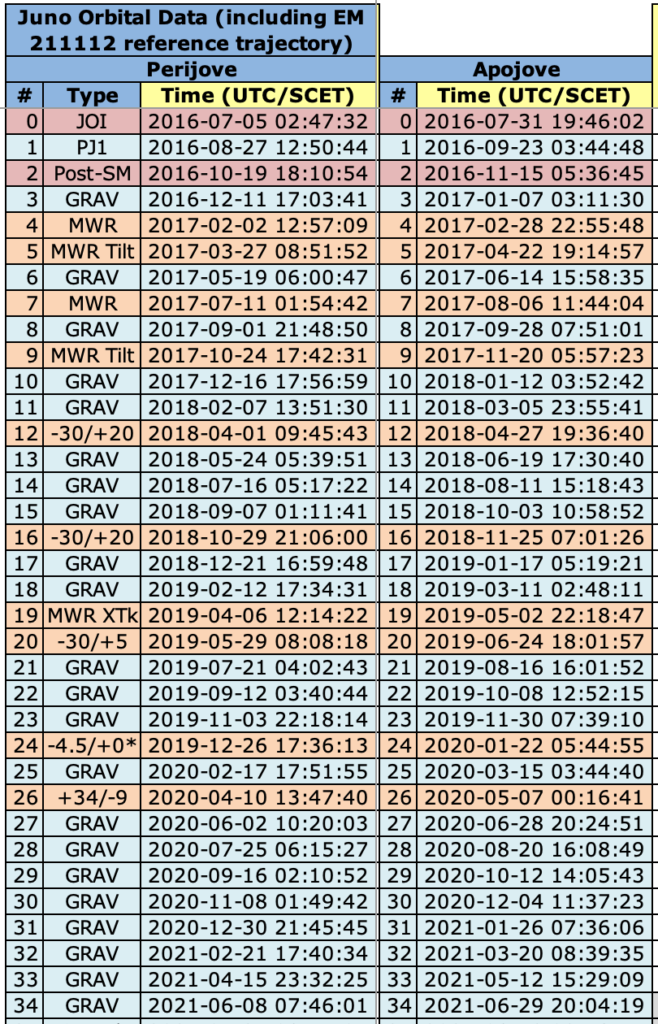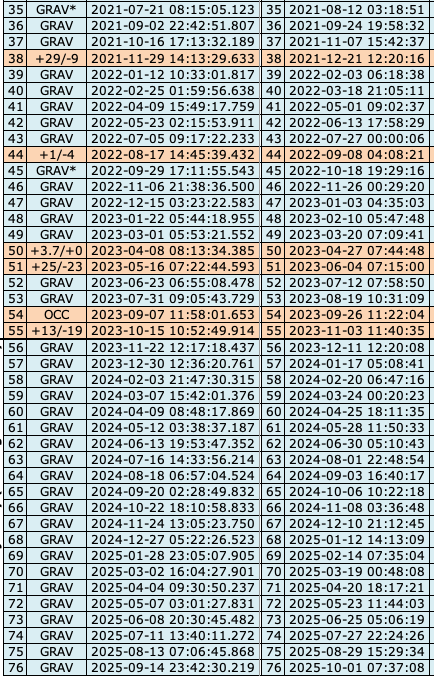Juno Trajectory Information
EXTENDED MISSION 2 – From PJ34 – for Prime Mission and Extended Mission 1 scroll down
Edited 22 Mar 2024
______________________________________________________________________________

_____________________________________________________________________
Note that the radius of Jupiter used in all coordinates is 71,492 km.
Extended Mission 2
Moon Flybys Spreadsheet from Marty Brennan
Wiggle Plots from Marty Brennan – 22 Jan 2024 – uses JRM33
Wiggle Plots-full PJ01-PJ17– PJ17-PJ34 – PJ34-PJ54 – P54-PJ76
Wiggle Plots-Zoomed PJ01-PJ34_Zoom – PJ34-PJ54_Zoom – PJ54-PJ76_Zoom
From Jack Connerney – 25 Jan 2024
Wiggle Plots – Zoomed PJ56-76
Pigtail Plots PJ1-76
FLUXTUBE CROSSINGS – From Vincent Hue – 22 Jan 2024
Readme, Spreadsheet, PJ01_05, PJ06_10, PJ11_15, PJ16_20, PJ21_25, PJ26_30, PJ31_35, PJ36_40, PJ41_45, PJ46_50, PJ51_55, PJ56_60, PJ61_65, PJ66_70, PJ71_75
M-SHELL PLOTS – From Jonas Rabia – 14 Mar 2024 – Readme, WigglePlots, M-vs-Time, spreadsheets: PJ1-15, PJ16-24, PJ25-32, PJ33-42, PJ43-56
________________________________________________________________
Extended Mission 1 – up to Orbit 55
WIGGLE PLOTS – Updated to JRM33 magnetic field model
WigglePlots-full – whole orbit – From Marty Brennan – 2 Mar 2022
Close-in wiggle plots – WigglePlots Zoomed In – From Marty Brennan – 2 Mar 2022
Close-in wiggle plots – Wiggle-JEC – From Jack Connerney – 27 Feb 2022
PIGTAIL PLOTS
PigTailsPJ1-34 , PigTailsPJ35-68 , PigTailsPJ69-77 – From Jack Connerney – 23 Feb 2022
FLUXTUBE CROSSINGS – From Vincent Hue – 20 Jan 2023
Readme, PJ01_05, PJ06_10, PJ11_15, PJ16_20, PJ21_25, PJ26_30, PJ31_35, PJ36_40,
PJ41_45, PJ46_50, PJ51_55, PJ56_60, TailXings-Spreadsheet
______________________________________________________________________________
PRIME MISSION – Through PJ34
Edited 24 Jan 2021
Science Activity Plans
Orbit Precession – PDF with orbits through PJ35 plotted and viewed from different angles (updated Jun 2018).
Dipole approximation to JRM09 – moment M=4.170 G offset from the rotation axis by θd =10.31o toward SIII Wlon of φd =196.61o.
Connerney’s JRM09 magnetic field model – Coefficients
Trajectory with JRM09 magnetic field from Jack Connerney – JRM09-Wiggles , PigTails
Iowa trajectory material – Masafumi Imai (24 Apr 2020) – University of Iowa website with Juno MWG trajectory information.
Satellite flux tube crossings using JRM09 from Vincent Hue (10 Dec 2020) PJ01_05_crossing PJ06_10_crossing PJ11_15_crossing PJ16_20_crossing PJ21_25_crossing PJ26_30_crossing PJ31_35_crossing
Wiggle plots – VIP4+CAN – For the trajectory uses dipole field with 9.6° tilt towards 202° System III longitude. For the fiducial field lines we used the VIP4 model with the CAN current sheet applied for local time dawn and longitude 202°. Sample field lines are shown for equatorial crossing distances of 5, 10, 20, 30, and 50 Rj for the zoom plots, 10, 20, 40, 50 Rj for the large plots. Small ticks show each UTC hour and large ticks show every 3 hours. Large black dots show the start of a new day, the red dot shows perijove, and the green dot shows 1 day before perijove. (Updated: Jun 2017): Wiggle Plot WiggleZoom Plot
Polar Plots – “Pigtail Plots” – VIP4+CAN – These plots show the magnetic footprint of the spacecraft (when within 10 RJ) projected onto the northern and southern hemispheres as viewed from above/below their respective poles (the way Juno sees the poles while flying over). They are calculated using the VIP4 magnetic field model. The large tick marks represent UTC hours. Small tick marks show every 15 min. Time of perijove is listed, along with the start and end times. (Updated: Jun 2017) North Footpoints South Footpoints
_______________
Polar Imaging – UVS Planning Tool – from Randy Gladstone and UVS team (Jul 10, 2017)
Deflection Angle Plots – These plots shows the angle between a model magnetic field and the Juno spin vector. These are used to determine when field aligned electrons are no longer in the field of view of JADE-E. (Jun 2017) Orbits 0-7 from C-Kernels on JSOC: DeflectionAngles_Zoom DeflectionAngles_FullOrbit
Operation Attitude Adjustment – Two presentations describing the possible spacecraft attitudes and orbit geometries for future orbits. OrbitGeometry&Attitude AttitudeAdjustment
Deflection Angle Plots (July 2017) for specific orientations using reference C-Kernels (Grav, MWR, MWRTilt, MWR Cross Track, 30 degrees off, 60 degrees off). DA=Deflection Angles, Zoom=+/- 6 hours for all models, Full=Entire Orbit with VIP4+CAN model, MaxDA shows the maximum deflection angle within +/- 2 hours of perijove, and Version 2 (V2) corrects the angles once orbit precesses past midnight (after orbit 22):
Maximum Deflection Angles Version 2: MaxDA_Table MaxDA_Plot
Gravity Attitude: DA_Grav_Zoom DA_Grav_Full
MWR Version 2 Attitude: DA_MWR_V2_Full DA_MWR_V2_Zoom
MWR-Tilt Version 2 Attitude: DA_MWRTilt_V2_Full DA_MWRTilt_V2_Zoom
MWR-CrossTrack Attitude: DA_MWRxTRK_Zoom DA_MWRxTRK_Full
30-Degree Tilt Version 2: DA_30off_V2_Full DA_30off_V2_Zoom
60-Degree Tilt Version 2: DA_60off_V2_Full DA_60off_V2_Zoom
COMPARISON (All 5 – except cross track – compared with VIP4+CAN +- 6 Hrs of PJ): DA_Compare_V2
Deflection Angle Plots – All 60 Degrees from Sun (24 Aug 2017). Each attitude is specified by two angles. In a coordinate system where X points towards the sun, Jupiter’s spin axis is in the XZ plane (with the z axis in the north within 4 degrees of the spin axis), and Y completes the set towards dusk, the first angle is the azimuthal angle rotation about the Z axis (with 0 towards the sun and positive angles towards dusk) and the second angle is the elevation off of the XY plane (with 0 towards the sun and positive angles in the northern hemisphere). We looked at elevations and azimuths from -60 to +60 at 10 degree increments.
Plots with fixed elevations and all azimuth angles: DA_Elevation-60 DA_Elevation-50 DA_Elevation-40 DA_Elevation-30 DA_Elevation-20 DA_Elevation-10 DA_Elevation+00 DA_Elevation+10 DA_Elevation+20 DA_Elevation+30 DA_Elevation+40 DA_Elevation+50 DA_Elevation+60
Plots with fixed azimuths and all elevations: DA_Azimuth-60 DA_Azimuth+60 DA_Azimuth+50 DA_Azimuth+40 DA_Azimuth+30 DA_Azimuth+20 DA_Azimuth+10 DA_Azimuth+00 DA_Azimuth-10 DA_Azimuth-20 DA_Azimuth-30 DA_Azimuth-40 DA_Azimuth-50
Orbit-by-Orbit plots (18 Sept 2017)
Angles at bottom right corner of plots are [+-Azimuth +- Elevation]
The net angle from the Sun for combinations of azimuth & elevation angles is tabulated here AngleTable
10Orbit 11Orbit 12Orbit 13Orbit 14Orbit 15Orbit 16Orbit 17Orbit 18Orbit 19Orbit 20Orbit 21Orbit 22Orbit 23Orbit 24Orbit 25Orbit 26Orbit 27Orbit 28Orbit 29Orbit 30Orbit
Trajectory IDL Save Files – Jan. 2018 OrbitSaveFileREADME – Zipped folders with save files – (Files are too large, so some tags removed and doubles reduced to floats. Contact us if you need additional information or higher precision.) Orbit00 Orbit01 Orbit02 Orbit03 Orbit04 Orbit05 Orbit06 Orbit07 Orbit08 Orbit09 Orbit10 Orbit11 Orbit12 Orbit13 Orbit14 Orbit15 Orbit16 Orbit17 Orbit18 Orbit19 Orbit20 Orbit21 Orbit22 Orbit23 Orbit24 Orbit25 Orbit26 Orbit27 Orbit28 Orbit29 Orbit30 Orbit31 Orbit32 Orbit33 Orbit34 Orbit35
DISCUSSION DOCUMENTS
UVS viewing – shows similar issue of viewing degrading as the orbit progresses from dawn to midnight
OrbitGeometry&Attitude AttitudeAdjustment – Two presentations describing the possible spacecraft attitudes and orbit geometries for future orbits.
PLOTTING TOOLS
Auroral Ovals – these files provide the inner and outer auroral ovals for the north and south main aurora as observed by HST. See Bonfond et al. (GRL 2012). Text file, IDL files.
Magnetic field models – in plots below showing auroral crossings the default magnetic field model is VIP4+Khurana current sheet. In some cases we show auroral crossings for 4 magnetic field models: VIT4=red, VIP4=blue, VIPAL=green, Khurana=yellow.Magnetic Field Models – comparison of VIP4, VIT4, VIPAL, Khurana – Io Flux Tube comparison
